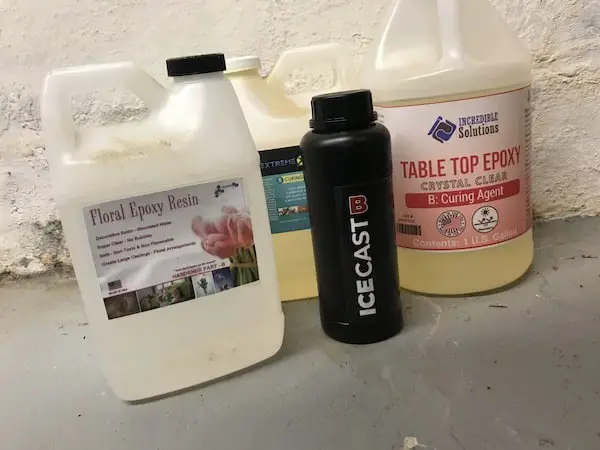
Oftentimes, I run low when working with epoxy resin, and because I like to try many different brands, I end up with mismatching products leftover. Using these can sometimes be tricky, but you don’t want to waste any. Here is what I’ve learned from being in this situation.
It is usually a bad idea to try to mix two different epoxy brands, unless you know that they come from the same manufacturer and have the same chemical makeup. It is okay to layer different epoxy brands in the same project, but if you need a single pour it’s best to buy the same brand to use with it.
While most base epoxies should be the same in theory, many are mixed with diluents that change the weight and volumes of the actual epoxy. Hardeners are definitely going to be different depending on which epoxy base they are intended for such as: viscosity, thickness of pour, temperature control, and curing time. If you want to use different epoxy brands together, it is best to layer them with separate pours. Otherwise, you can try to mix the brands together, but you may end up ruining your epoxy.
How to Mix two Different Epoxy Brands
If you decide that you really need the pour to be all at once and not layered, then you can still attempt to mix brands and pour. I do not suggest this, but I will give some advice for this here.
Before anything, try doing a small mix/pour (maybe jewelry or a coaster) to see how it reacts. This can give you an idea of how the different epoxies and hardeners will interact with each other. If you end up with epoxy that is not fully hardened, perhaps try adding a little more hardener next time around. If you luck out, you may just have a perfectly fine pour as is.
Once you do pour, monitor the temperature regularly. If your epoxy is getting too hot it will be moving quite a bit as it expands and could begin to smoke. If your epoxy is staying too cool you could consider heating it up, either with a space heater or something else, in order to help it cure faster.
Be ready to be disappointed. The reality is that different brands are not made to mix, and you could end up with unexpected results. It may overheat and end up cracking, or it could never fully cure and leave you with more rubber-like epoxy. I even had someone tell me they ended up with very cloudy epoxy (I’m guessing bubbles, but it could be due to a chemical reaction). As long as you are willing to lose your epoxy and project, it may be worth experimenting with.
For most people, the risk won’t be worth saving a little epoxy. In almost all cases, I suggest purchasing the same epoxy that you have leftover of and mixing the same epoxies. That or saving the leftover for a small pour like jewelry or a top coat is a great way to use all your epoxy resin.
How to Layer Different Epoxy Brands
If you have been doing epoxy work for a little while now, this question will seem pretty obvious to you. However, for anyone who wants to be safe, I would suggest doing this a little differently than I would when layering the exact same brand.
To layer different epoxy brands, pour the first layer and allow it to cure fully (usually 24-72hrs). Then sand the layer with a 80-220 grit sandpaper, clean off any dust and make sure it is dry. Now you can pour the second layer. Repeat this step any time you are layering separate brands.
Usually, when layering epoxy, I will pour, and wait anywhere from 2-12 hours, and then pour again before it is fully cured. This allows me to avoid doing the sanding and cleaning, which leaves room for errors and dust. Unfortunately, you never know exactly how the different epoxy brands will work when doing this. Due to unknown potential chemical reactions, it is best to wait until the epoxy is fully-hardened and go through the sanding and cleaning process. This minimizes any risk of ruining your epoxy in the process.
Conclusion
While at first when you look at epoxy, it may seem like no big deal to mix different epoxy brands – especially when considering they have the same mix ratio. While this is tempting for someone who jumps brands (whether that is a cost-based or intrigue-based decision), it is not advisable to do so. Mixing epoxy brands could cause more harm then good, particularly if they come from different manufacturers and have things added to them to increase volume – which is very common. If there is a way to confirm that these epoxies are private-label, and from the same manufacturer, it may be fine to mix them. The best thing to do in this case, before mixing for a pour, is to try mixing a very small amount to make sure it works as expected. If they are not from the manufacturer you really have four main options to use this epoxy:
- Save it for small pours
This is a good idea if you will be pouring small amounts in the near future - Buy the same brand and mix
This works great if you don’t mind purchasing another set of epoxy. Personally I can never have too much epoxy - Layer the epoxy
This is perfect if you don’t mind a bit of extra time pouring and putting in the extra work of sanding and cleaning the layers - Mix it anyway
I never advise this, because of the other three options this seems like an unnecessary way to go


